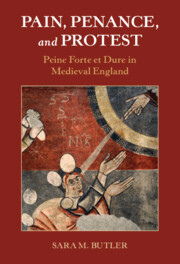Book contents
- Pain, Penance, and Protest
- Studies in Legal History
- Pain, Penance, and Protest
- Copyright page
- Contents
- Tables
- Acknowledgments
- Table of Statutes
- Abbreviations
- Introduction
- 1 Peine Forte et Dure: The Medieval Practice
- 2 Standing Mute in the Courts of Medieval England
- 3 Due Process and Consent to Jury Trial
- 4 Peine Forte et Dure as Barbarity? Putting the Practice in Context
- 5 Why Stand Mute?
- 6 Standing Mute as Imitatio Christi
- 7 Rejecting the Jury, Rejecting the Common Law, Rejecting the King
- Conclusion
- Bibliography
- Index
2 - Standing Mute in the Courts of Medieval England
Published online by Cambridge University Press: 19 November 2021
- Pain, Penance, and Protest
- Studies in Legal History
- Pain, Penance, and Protest
- Copyright page
- Contents
- Tables
- Acknowledgments
- Table of Statutes
- Abbreviations
- Introduction
- 1 Peine Forte et Dure: The Medieval Practice
- 2 Standing Mute in the Courts of Medieval England
- 3 Due Process and Consent to Jury Trial
- 4 Peine Forte et Dure as Barbarity? Putting the Practice in Context
- 5 Why Stand Mute?
- 6 Standing Mute as Imitatio Christi
- 7 Rejecting the Jury, Rejecting the Common Law, Rejecting the King
- Conclusion
- Bibliography
- Index
Summary
Peine forte et dure was the sentence imposed on suspected felons who stood mute, that is, who refused to plead. Chapter 2 speaks to the process of standing mute in the courts of medieval England, with the underlying goal of assessing the challenges an accused felon faced in negotiating the legal process sufficiently to develop a solid defense strategy. Not only were there multiple means of standing mute, but silence only sometimes functioned as a refusal to plead. Distinctions were made based on venue, process, and the nature of the charge. Historians have often assumed that medieval justices, like their early modern counterparts, did not permit silence upon appeal or treason. The medieval evidence demonstrates that these rules developed late and were enforced at the discretion of the justices. Gender also mattered in the formulation of a defense strategy: women rarely opted to stand mute, but those who did were in dire straits. The one redeeming feature for the defendant is that the king’s justices acted as counsel for the defendant, meaning that they were tasked with explaining the intricacies of pleading procedure to the defendant so that he might make an informed decision.
- Type
- Chapter
- Information
- Pain, Penance, and ProtestPeine Forte et Dure in Medieval England, pp. 80 - 133Publisher: Cambridge University PressPrint publication year: 2021



